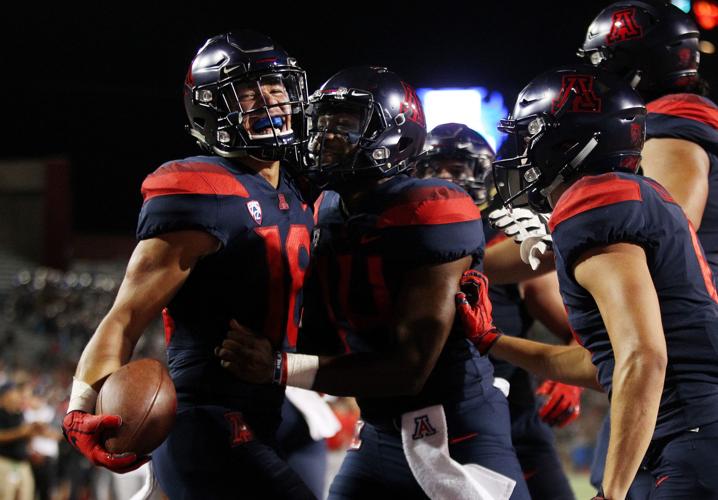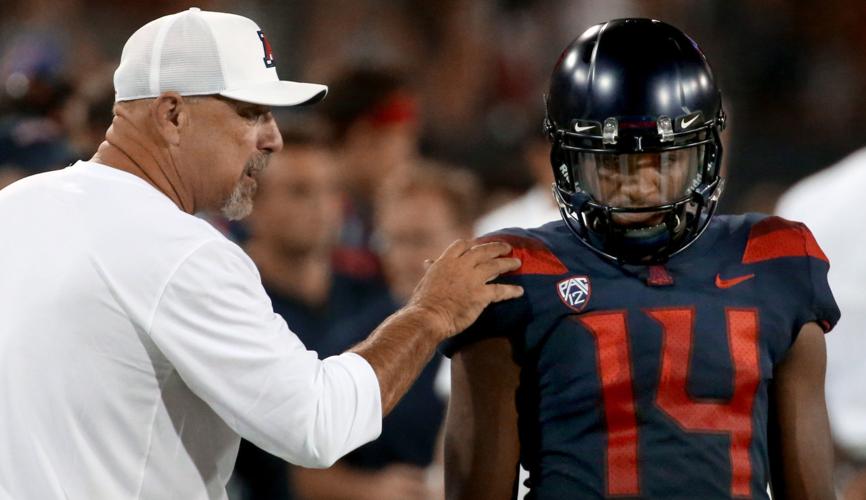Is it possible to be a quarter of the way through a season and not really know whether a team is any good?
That might very well be the case with the 2018 Arizona Wildcats — and their counterparts in the Pac-12 opener Saturday afternoon.
Arizona and Oregon State each have one victory — over FCS Southern Utah. Each has a close loss and a blowout loss.
UA coach Kevin Sumlin was pleased with the progress his team showed against the Thunderbirds. He’s also been around long enough to understand that context is everything. Southern Utah plays in the Big Sky Conference. It isn’t the Pac-12.
“There were some positives,” Sumlin said. “But … there’s still a lot of work to do.”
The challenge comes in deciphering what’s real and what isn’t. Take the offensive line, for example. There’s no question that the unit performed better with left tackle Layth Friekh back in the lineup. The fifth-year senior is Arizona’s best and most experienced lineman.
Sumlin said getting Friekh back, moving freshman Donovan Laie to right tackle and shifting Cody Creason to left guard — giving Arizona two athletic veterans on the left side — changed the line “dramatically.”
But Sumlin’s optimism was tinged with caution.
“We’ll have a better feel for where they are after Saturday afternoon,” he said.
While some dismiss the idea of Oregon State as a threat — and believe the true test of Arizona’s legitimacy will come the following week against USC — the Wildcats don’t view it that way. Sumlin described his message to the team — about getting better every week — as “internal.”
In that sense, the opponent is irrelevant.
“I feel like with any team, it’s always us,” UA defensive end Jalen Cochran said. “If Arizona doesn’t beat themselves, then we’ll win the game.”
Quarterback Khalil Tate played carefully yet daringly last week. Aside from a fumble on a second-quarter run, Tate took excellent care of the ball. When it came time to take shots down the field, Tate didn’t hesitate and threw the ball with pinpoint accuracy.

Oregon State knows Khalil Tate can beat a team with his arm or his feet. He ran for 206 yards last year against the Beavers, and threw for 349 yards against Southern Utah last week.
But it’s fair to question whether that model is sustainable. Tate and his receivers connected on four passes of 53 or more yards. Those plays accounted for 248 of Tate’s career-high 349 passing yards. He wasn’t nearly as effective throwing the ball downfield the previous two weeks against better competition.
Regarding Tate’s apparent improvement, Sumlin again proceeded with caution.
“Just like everybody,” he said, “we’re all a work in progress.”
The Beavers are preparing for the best version of Tate — some combination of the player who passed for 300-plus yards last week and rushed for 200-plus against them last season.
“What he’s done this season is scary stuff,” OSU coach Jonathan Smith said. “He’s throwing the ball from the pocket, and I think he’s doing it well. He lit up the scoreboard last weekend.”
Although Tate hasn’t been fully healthy the past two weeks because of a left ankle he sprained against Houston and aggravated against Southern Utah, opponents continue to defend him as if he’ll take off at any moment. It sounds as if the Beaves will deploy a similar strategy.
“There’s always the factor on a pass play of him pulling it and going,” Smith said.
“We’re going to need to be able to change up our schemes. But it starts with the quarterback — keeping him somewhat contained. I don’t think you can totally keep him contained — he’s just that good a player. We’ve gotta have an answer for him on every snap.”
Tate’s passes weren’t the only big plays last week. J.J. Taylor returned a kickoff for a touchdown — the first by Arizona on a deep kick since the Mike Stoops era.
Taylor’s 84-yard return served as the first substantial proof that Sumlin’s emphasis on special teams is having an impact. In additional to Taylor’s dash, sophomore kicker Lucas Havrisik made both of his field-goal attempts and booted all 11 of his kickoffs into or through the end zone for touchbacks.
Havrisik’s attitude regarding his performance is one his teammates ought to emulate.
Eighteen of Havrisik’s kickoffs have resulted in touchbacks. But he thinks a lot more about the two that he “messed up.” His goal for the season was 100 percent.
“I’m going to hold myself to a high standard,” Havrisik said.
He applies the same approach to field goals. Havrisik said he’s “not very happy” with his numbers so far; he has made four and missed two.
“But you can’t really worry about it,” Havrisik said. “Gotta go to the next kick. I’m fixing that right now.”
Havrisik went so far as to take blame for his first missed field goal, in Week 1, which was blocked.
Sumlin delivered a similarly frank assessment of his team immediately after the Southern Utah game, saying the Wildcats had to be “honest” with themselves when they returned to work the next day.
“What are our deficiencies?” Sumlin asked. “Where can we get better? What do we need to do?”
The defensive players who spoke that night seemed to realize they still had a long way to go.
One said the defense needed to become more physical; another said the unit needed to communicate better.
Arizona finally registered a sack (two, actually) and a takeaway but continued to struggle on third down. Southern Utah ran 98 plays and gained 463 yards. Oregon State averages 522.0 yards, tops in the Pac-12.
Skeptics will say that figure is bloated by the 649 yards the Beavers gained against the Thunderbirds. They might say the same about the Wildcats, who gained 626.
The beauty for Arizona and OSU is that both are 0-0 in conference play. No matter what’s happened so far — and no matter whom it happened against — their goals remain attainable.
“We take each week … week by week, game by game,” UA senior receiver Shun Brown said. “We build off each game. Now it’s Pac-12 play, and we know what our goal is: It’s to win the Pac-12 championship. Moving forward, we’ve just gotta … be the best team we can be.”






